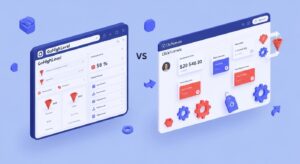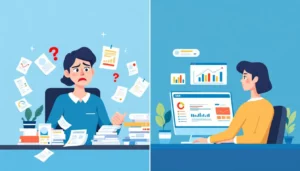Mastering Client Experience: How CRM Shapes Agency Success

One thing that sets companies apart today is how well they treat their customers. Still, it’s very important to be original and get results that can be measured. The ones that make sure everyone has a great time are the ones that keep customers and grow. You can easily get in touch with a business today, and they should meet your needs, be open and honest, and give you service that goes above and beyond.
In this way, CRM systems have changed from just keeping records to being useful tools for businesses. CRM client experience agency strategies are now very important because they help agencies get to know their customers better, guess what they’ll need, and get more done. A CRM does more than just help with business when it’s used right. It changes how customers see the business and how they deal with it too.
The Shift Toward Experience-Driven Agencies
People are upset with all the reviews and changes. Companies should know what they need, give them correct information, and keep them up to date at all times. It was found by HubSpot that most people will stick with a business even when things get tough if they had a good experience with them.
In this case, agents need to change their focus from making deals to making links based on events. This is possible with CRMs because they gather information about clients, keep track of all contacts, and use that information to give you useful insights. It will be hard for groups that guess or use information that is spread out to follow these stricter rules. On the other hand, businesses with well-run processes can keep a lot of people safe and make a lot of money.
Centralizing Client Information for Better Service
Clients get angry when you don’t understand them or ask them the same questions over and over. When important things are spread out across many tools, files, and email lines, it’s easy to lose track of them. That’s why you need a CRM. It keeps all of your customer data in one place. The whole team can see every meeting, goal, project report, and plan note.
Being this careful with your plans really helps the work get done well. When teams don’t have to remember things or look through old texts, clients can tell that a business is doing a good job. If you show that you care about and understand them right away, people will trust you more.
When all agencies do things the same way, they can get more done in less time and with less chaos in management. You shouldn’t just make deals with clients whenever you want for the agency model to work well. Instead, it should be more like a planned relationship.
Personalizing Interactions at Scale
People today want things to be made just for them. People hire lawyers to make sure they know what they want, how they like to talk, and what they need. You can do this with CRMs since they save essential customer information and communicate it with everyone on the team. Agents can change how they help you make a plan or how they write a letter to follow up.
Clients get texts and reports that are useful to them because their daily tasks are different. They don’t feel like just another account, but like a partner. McKinsey has found that businesses that personalize well grow a lot faster than businesses that don’t. If people feel like they’re getting what they want, they’ll likely stay with a business for a long time.
Enhancing Onboarding Experiences
The first people who come to mind are those who want to hire a business. People quickly start to doubt their choice when they are taught slowly, in a jumbled way, or not clearly. Your goals will be clear, and you can talk about the next steps right away with a CRM. This helps you hire the right people quickly.
Agents can speed up some of this so that it’s the same for everyone. You can quickly clear up any confusion and build trust with digital intake forms, welcome routines, and a neat way to keep track of tasks. Gartner suggests that organizations should make more consumers wait in the first several months. This is the first step in meeting people and keeping them helpful for a long time.
Creating Transparent Reporting and Feedback Loops
When you are open and honest, people trust you more. People who hire you want to know how the job is going, why decisions are being made, and where their money is going. With the help of the feedback tools that come with CRMs, this level of awareness can be kept up over time.
Monitors let clients see their success right away, so they don’t have to wait for a call once a month. Reports can be set to run at certain times, so clients are always up to date. This touch every so often makes things clear and shows that someone is in charge.
Customer relationship management (CRM) systems with effective feedback loops may also improve the customer journey. Ask people what they think and feel a lot of times over time. This will help the government find issues and fix them quickly. When you respond in this way, customers will feel like you care about what they have to say.
Supporting Proactive Problem-Solving
A business with great customer service doesn’t just fix issues as they come up; they plan for them. Teams can use CRMs to look for patterns that could mean trouble is coming before it does. It could mean that you need to change how you think about success, give up on something, or give it more thought before you decide what to do.
When these signs show up in the CRM, the workers can move quickly. When they get together, they can talk about their plans, their goals, or how to get more help. They will know that the company cares about their projects and wants them to do well.
Strengthening Collaboration Through Portals and Automation
It’s even better to work together when CRMs are related to client websites. Clients don’t have to worry about their safety when they look over important papers, project plans, and performance reviews there. It’s excellent that teams don’t have to jot down modifications and comments by hand.
This method of speech makes it easier for everyone to understand each other and remain on the same page. Both teams and clients prefer being able to communicate to each other immediately away. HubSpot recognizes that customers are satisfied when they can readily reach them with well-made products.
Measuring Experience for Continuous Improvement
Things should always be better than they are, even if you have great customer service. As a business grows, CRMs tell it things that can help it do better. What kind of business is doing well? Look at how many busy clients there are, how long they stay with the business, and how fast they answer.
McKinsey says that businesses that always work to improve based on what customers say make more money and gain more trust from customers than businesses that don’t do this. Follow these steps to make sure that the customer experience is always a top priority for your business and not just something you think about at the end of the day. It also gives leaders information from the real world that they can use to train their teams and change the way things are done.

Conclusion
How well an agency does now depend a lot on how happy its clients are. Clients often choose to stay or leave based on how they feel during their trip, even though creativity and success are important. With the help of CRM tools, agencies can prepare, cater, and plan for this.
CRM client experience agency strategies can turn an unexpected meeting with a client into a planned, purpose-driven client trip. Agencies build trust over time by putting all of their data in one place, making exchanges more personal, hiring better people, supporting openness, and getting people to talk to each other more than they need to.
When companies use CRM to make the customer experience a business goal, it’s not enough for them to just be service providers. They make links that help people grow over time.







